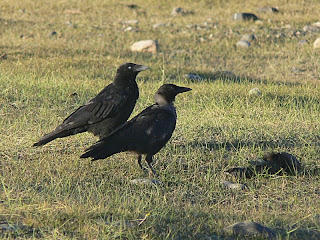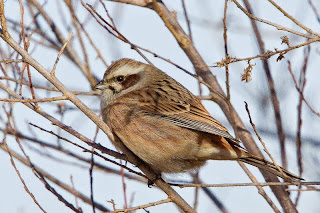Two goodies at noon
text & photos by Abu
(© A. Buchheim)
So far, this “cold season” has been a winter for wimps. Compared to the average Mongolian winter, temperatures have been 20 degrees Celsius higher—and that is a lot. No wonder that there are still tiny stretches of the Tuul River which are not frozen over and up to two White-throated Dippers of the beautiful subspecies C. c. leucogaster have been seen at one of these openings (see here, for example). Amarkhuu, a member of the Mongolian Birdwatching Club, had reported a Water Pipit, so I went down to the Tuul on 16 January 2015 to check out the dippers and search for the pipit.
Central Asian Water Pipit
Tuul River, UB, January 2015
Central Asian Water Pipit
Tuul River, UB, January 2015
Central Asian Water Pipit
with a Plecoptera larva, Tuul River, UB, Jan 2015
Central Asian Water Pipit
Tuul River, UB, January 2015
Central Asian Water Pipit
Tuul River, UB, January 2015
Pipits are not known to overwinter in Mongolia (but dippers do! cf here, here and here) and hence any pipit seen in January is a very good find. Theoretically, a “water” pipit along a river during the winter time could be also Buff-bellied Pipit which winters not far to the south; and even a Red-throated Pipit had once been found in the Khangai in early winter: on 2 December 2007 in Tsetserleg, see here.
Well, the dippers eluded me, but I found the pipit and, indeed, it was a Central Asian Water Pipit. The local taxon blakistoni has recently been proposed to be a candidate for a future split from spinoletta of Europe and coutellii of the Asia Minor and the Caucasus (Martin Garner, Yoav Perlman, Yosef Kiat & Martin Collinson 2015: Water Pipits: three species rather than one? British Birds 108: 42-48).
Note on Water Pipit phenology in W Mongolia: Axel has one winter record from westernmost Mongolia: One at Khovd river c18 km NE of Olgii city, Bayan-Ölgii Province on 9 March 2001. In 2006 and 2007, he recorded the species in Khovd town, at the foot of the Mongolian Altai during migration from early April (7 Apr 2006, 6 Apr 2007) to early/late November (9 Nov 2006, 28 Nov 2007).
Hooded Crow
Tuul River, UB, January 2015
Hooded Crow in flight
Tuul River, UB, January 2015
On my way back to the car, a calling crow reminded me to check the crow flock which usually hangs around the river. I had already asked my fellow Mongolian birdwatchers to inform me if they would come across a Hooded Crow, a species I have never seen in Mongolia. Since several winters I have searched for it myself, alas all in vain. But now—bang—the caller was a Hooded Crow! I hastily fired a series of record shots and left for home.
There are not many records of Hooded Crow for Mongolia, and, given its western distribution, records could be expected mainly from the west of the country. During his time in Khovd, Axel has seen no Hooded Crow, and only once (10 Sep 2006) two hybrids between Hooded and Oriental Crow, and prior to that, one bird which might have been a pure Hooded Crow just outside Olgii town on 9 March 2001.
record shot of Corvus - hybrids
Oriental C. (corone) orientalis x Hooded Crows C. cornix sharpi
Buyant river near Khovd, 10 Sep 2006. © A. Bräunlich
Kozlova (1933) mentioned in her major multi-part paper The Birds of South-West Transbaikalia, Northern Mongolia and Central Gobi (1932/33) that „Hybrids of this [Eastern Carrion Crow] and the Grey Crow (Corvus cornix sharpii) were met with on several occasions in the Lacustrine Depression and the vicinity of Ulan-bator.”
In recent years, it had been photographed at least once in Selenge Province, northern Mongolia, and in the greater UB area at least two times: One bird had been photographed near the Manzshir monastery on the south side of Bogd Khan Mountain and the second individual had been photographed in UB few years ago. The Mongolian Red List of Birds (2011) unfortunately does not give any information on this taxon.
When dealing with these birds one has to make sure that you are not looking at a hybrid between cornix and orientalis. The January-2015 bird had no extra streaks on its hind neck, no extra black on its underwing and all-grey under tail coverts hence does not exhibit any treats of orientalis influence.
Therefore it safely can be called Hooded Crow—thus this is the third modern record for Greater UB, yeah!
I also could take pictures of some commoner species as well and include some for pleasure here, enjoy.
Azure Tit
Tuul River, UB, January 2015
Azure Tit
Tuul River, UB, January 2015
Azure Tit
Tuul River, UB, January 2015
Male Meadow Bunting
One out of c220 seen, Tuul River, UB, Jan 2015
Male Northern Bullfinch
This singing guy popped out of the shade for
a few seconds, Tuul River, UB, January 2015













2 comments:
Excellent records!
Igor
PS: in this winter and a previous one, a group of several C.cornix is recorded in Irkutsk. Not unusual here, but it is a rare case to see several birds.
Post a Comment